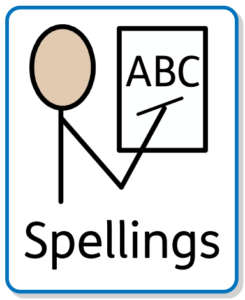Spelling

We aim for children to develop a secure knowledge and understanding of the relationships between words, word meaning, implied meaning and figurative language within writing lessons, whilst ensuring that children are supported in their spelling strategies. We believe that children transition through various stages to become competent and confident spellers:
Preliminary Spellers
Children use scribbles, letters, and letter-like forms. There is no understanding of phoneme-grapheme correspondence. Children’s writing shows a lack of understanding of conventions of print such as spaces between words and left to right progression of writing.
Semi-phonetic Spelling
Children show a developing understanding of phoneme-grapheme correspondence and attempt to use them. They use phonemes which are most obvious – initial and final (wt for went) or initial/medial/final (bab for baby). Children use whole words with 2 or 3 letters mostly consonants (ktn for kitten).
Phonetic Spellers
Children choose phoneme-grapheme correspondence on the basis of the sound of a word rather than conventional spelling patterns (wen for when, wich for witch). They mostly represent the phonemes in a word (necst for next, peepl for people). Alternative graphemes are insecure (ai, ay, a-e, eigh, a, ey). Children write as they speak (fink for think, apsolootlee for absolutely).
Transitional Spellers
Children move from sounds to structures and use graphemes to represent all consonant and vowel phonemes with vowels in all syllables (enchanted, castel for castle). Children may still over-focus on the sound of words and misunderstand word boundaries (curry door for corridor). They begin to use other strategies – knowledge of common letter patterns, critical features of words (silent letters, double consonants) and making analogies. Children develop a growing bank of known words.
Independent Spellers
Children are aware of the many patterns and rules of the English spelling system, including uncommon patterns and irregular spellings (ceiling, pleasure), which they can generalise and apply to unfamiliar words. They use prefixes and suffixes, and a range of strategies to spell words, whilst developing an understanding of when a word does not look right. Children have a large bank of known words.
Spelling is taught across the school throughout the week and builds on children’s prior knowledge.
Nursery, Reception, Year 1 and Year 2
In nursery, reception, year 1 and year 2, (and for individual children across Key Stage 2 where necessary), Read, Write Inc is the vehicle which drives phonic acquisition.
Common exception words Year1
Common exception words Year2
Years 3-6
Years 3 to 6 focus on spelling lists appropriate to the age of the children they teach. Spelling lists focus on spelling patterns and rules and are learnt and revisited throughout the school year and applied in the children’s writing.
